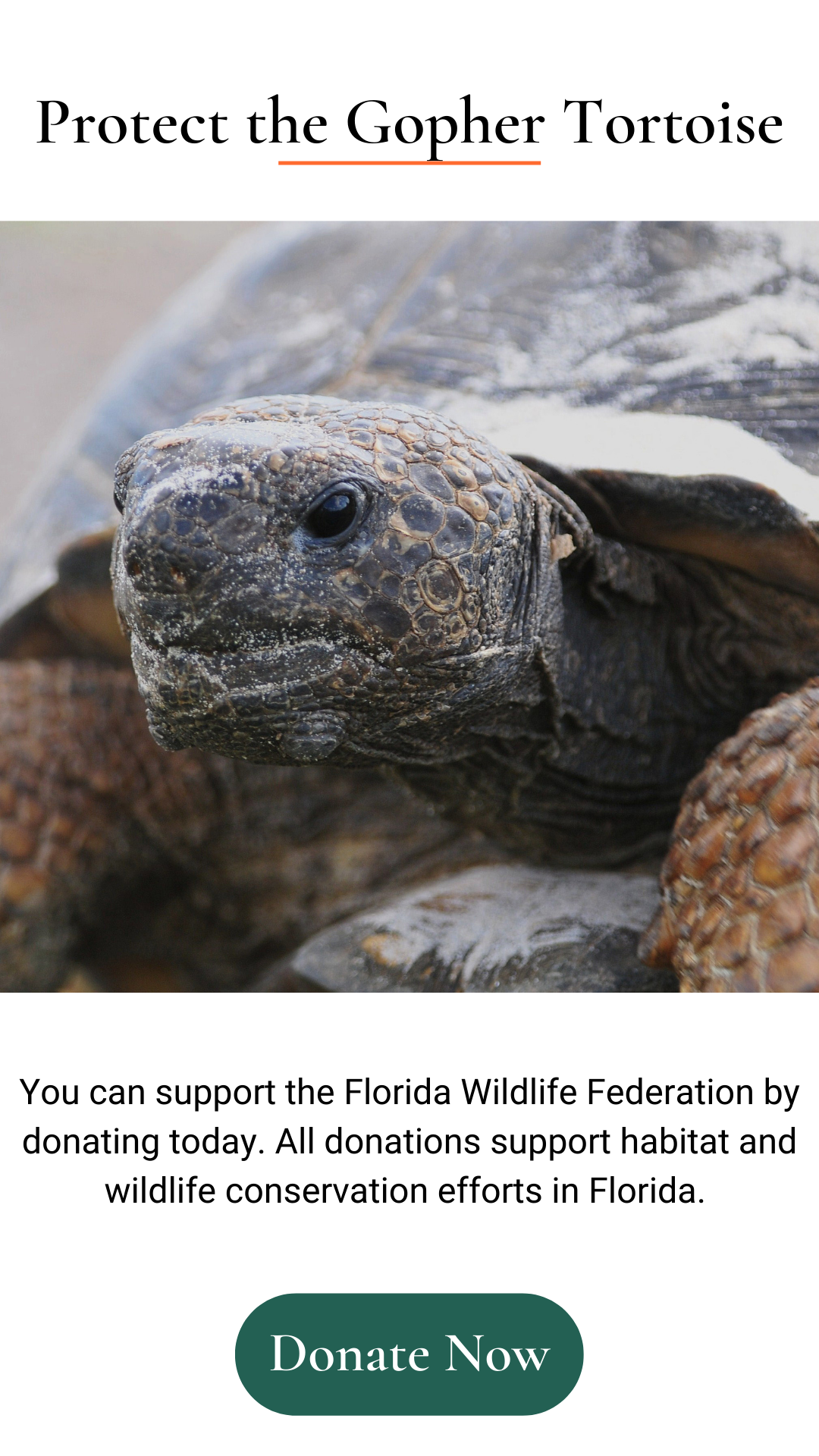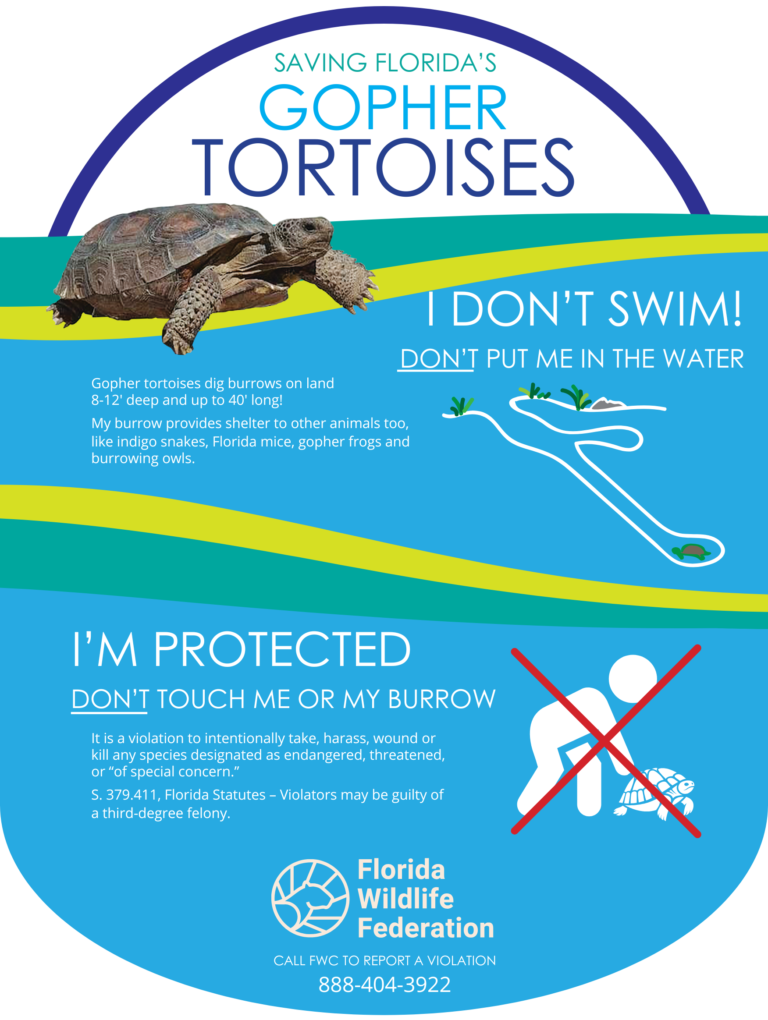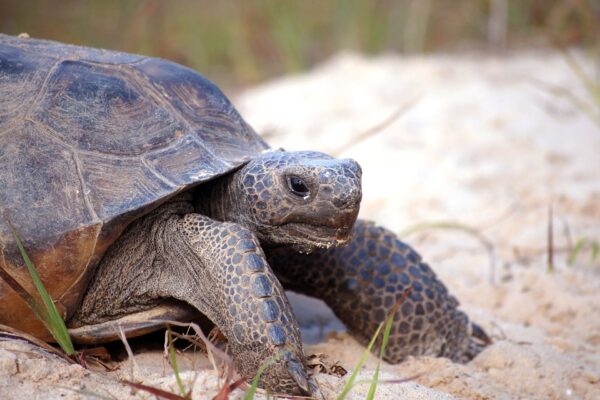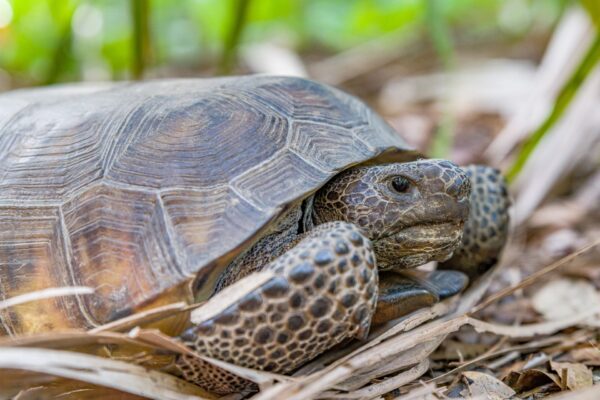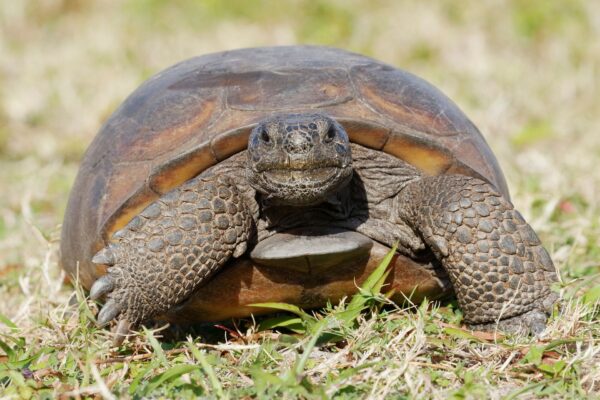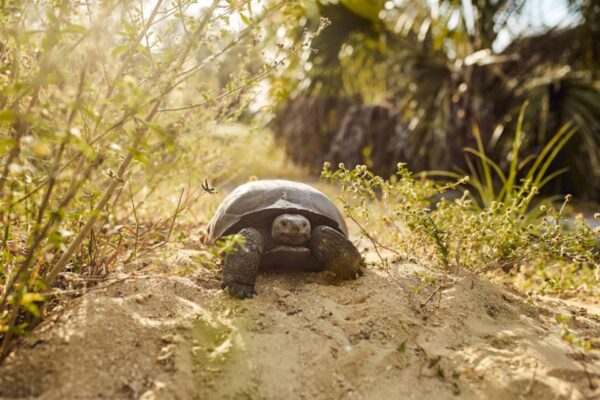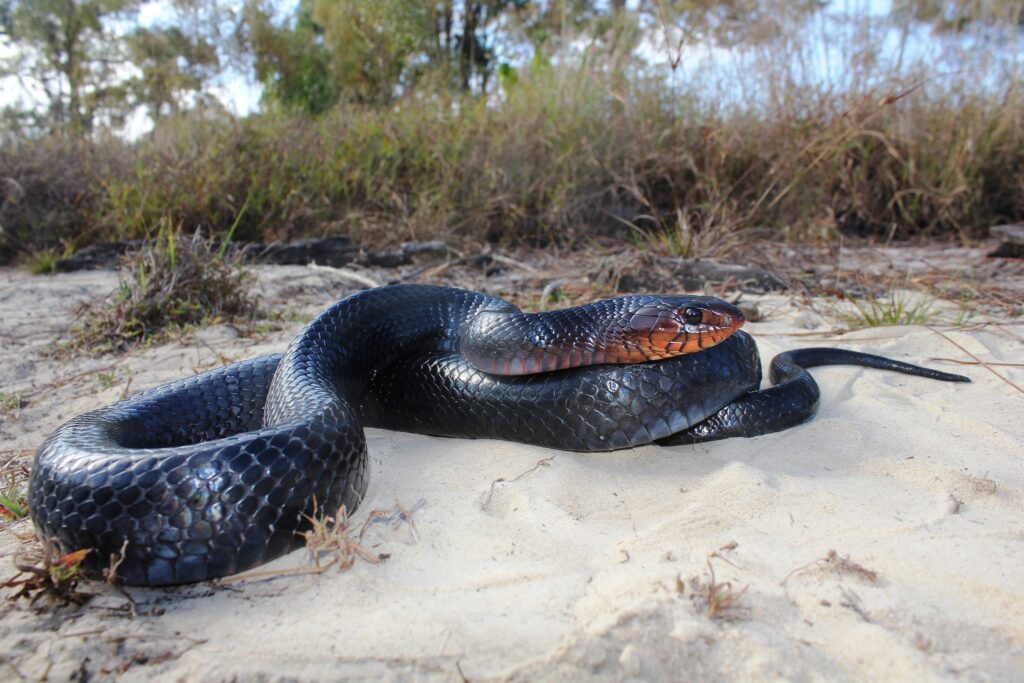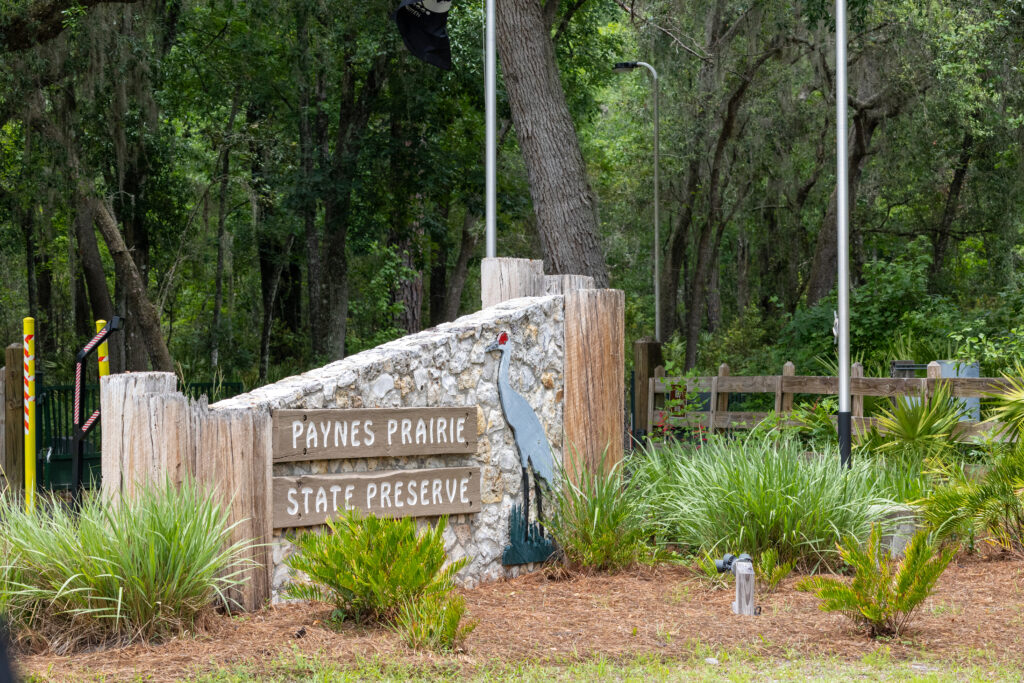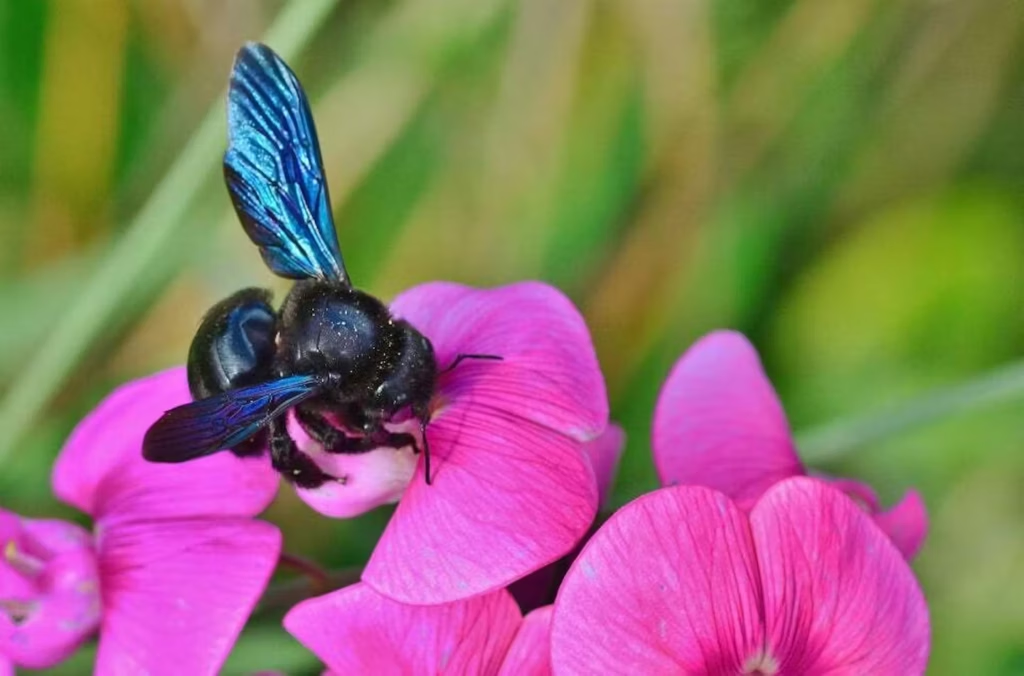Gopher tortoises play a vital role in Florida’s ecosystems, sharing their burrows with over 350 other species.These burrows provide essential shelter and protection from predators, making gopher tortoises a true keystone species—one whose presence is critical for the survival of many others. Protecting gopher tortoises means safeguarding an entire web of life.
The GopherTortoise
Protecting the Gopher Tortoise
The Gopher tortoise (Gopherus polyphemus) is the only native tortoise species east of the Mississippi River and its range includes all 67 counties in Florida. Known for digging deep burrows that provide shelter for hundreds of other species, these tortoises play a vital role in their ecosystem. However, habitat loss due to development continues to threaten their populations.
- Habitat: Sandhills, scrub, pine flatwoods, coastal dunes
- Population: Estimated at 700,000–800,000 individuals in Florida
- Conservation Status: Listed as “Threatened” in Florida
Today’s Challenges
Gopher tortoise populations have declined significantly throughout their range, especially in the western and northern areas of Florida. Habitat loss, road mortality, fire suppression, and ongoing development continue to threaten this keystone species and the 350+ species that rely on its burrows for shelter. These threats put animals like the Eastern indigo snake, gopher frog, Florida mouse, and numerous invertebrates, such as beetles and crickets, at risk as well.Urbanization and land conversion have fragmented their natural habitats, forcing tortoises to cross roads more frequently, increasing the risk of vehicle collisions. Fire suppression has led to overgrown landscapes that are less suitable for tortoises, while continued development further reduces the availability of critical habitat.
Conservation in Action
The Florida Wildlife Federation is actively working to protect the critical habitat gopher tortoises and other native wildlife depend on. Through efforts to conserve public and private lands and establish connections between them, we aim to safeguard the ecosystems that sustain this keystone species.
As part of our commitment to education, FWF has developed informative signs to teach the public how to safely interact with this threatened species. Since 2016, and with your support, over 300 signs have been installed in natural areas like state and county parks, forests, beaches, and nature preserves. These signs, distributed to public agencies and nonprofits, serve as valuable tools in raising awareness and fostering respect for gopher tortoises.
Many of our partners also provide educational programs to deepen understanding of gopher tortoises and their role in Florida’s ecosystems. By supporting these efforts, you help us continue to protect and celebrate this remarkable species.
Learn About the Gopher Tortoise
Gopher tortoises are sturdy, land-dwelling reptiles built for digging. They have strong, elephant-like hind legs and front legs covered in thick scales, with wide, shovel-like feet specialized for burrowing into sandy soil. Adult tortoises typically measure 9-11 inches in length, though some can grow up to 15 inches, and they weigh 8-15 pounds. Their domed shells range in color from tan to brown or gray, providing natural camouflage in their dry, sandy habitats.
Hatchlings and juveniles have a yellow-orange and brown shell, which gradually fades to darker tones as they age. Unlike aquatic turtles, gopher tortoises are strictly terrestrial and cannot swim. Though some populations live near coastal dunes, they do not enter the water and rely entirely on dry, well-drained soils for survival. If placed in water, a gopher tortoise is at risk of drowning. Their feet are adapted for digging, not swimming, making them completely dependent on land-based habitats.
Gopher tortoises have been on the planet for 60 million years and have faced significant conservation challenges in the last century. Historically, their populations thrived across the southeastern U.S. reaching from North Carolina to Texas, but habitat destruction, urban development, and human-related threats led to severe declines..
By the late 20th century, gopher tortoises disappeared from large portions of their range, including much of the Florida Panhandle and southeastern coastal regions.
The gopher tortoise was first recognized as a Species of Special Concern in Florida in 1979 and later reclassified as a State-designated Threatened species in 2007 due to significant population declines. Legal protections, including habitat conservation measures and relocation requirements, were put in place to slow their decline. However, habitat loss remains a major threat, and conservation efforts continue to focus on preserving remaining tortoise habitats, restoring longleaf pine ecosystems, and reducing human impacts.
While gopher tortoise populations have stabilized in some areas, they are still state-listed as Threatened in Florida, and western populations in the U.S. are federally protected. Continued monitoring, habitat protection, and public awareness efforts are crucial to ensuring the long-term survival of this keystone species.
The primary threat to the gopher tortoise is habitat loss and fragmentation, which have drastically reduced the open, sandy landscapes they depend on. Once abundant across the southeastern U.S., longleaf pine forests, scrub, and dry prairies have been cleared for development, leaving tortoises with fewer places to dig their burrows and find food. As roads, buildings, and other structures divide their habitat, tortoises are forced to navigate fragmented landscapes, increasing the risk of road mortality, especially for females searching for nesting sites.
It is illegal to harass, handle, or relocate a gopher tortoise without proper authorization, as both the tortoise and its burrow are protected under state law. However, if you see one crossing a road, and it is safe to do so, you may carefully pick it up and move it across in the same direction it was headed to help prevent road-related deaths. Always handle the tortoise gently, keep it close to the ground to avoid injury if dropped, and never take it to a different location.
While gopher tortoises are protected under state law, land development continues to impact their populations. Before any clearing or construction occurs, property owners must obtain permits from the Florida Fish and Wildlife Conservation Commission (FWC) to relocate tortoises to approved recipient sites. However, relocation does not fully replace the lost habitat, and maintaining large, connected areas of undeveloped land remains critical for their survival.
Gopher tortoises are long-lived, burrowing reptiles that spend much of their time underground. In the wild, they can live 40-60 years, while captive tortoises have been known to live over 90 years. Males reach adulthood at approximately 9-12 years of age, while females may take 10-21 years to mature.
Unlike aquatic turtles, gopher tortoises are strictly terrestrial and cannot swim. Their strong, shovel-like front legs are designed for digging, not for paddling through water. If placed in water, a gopher tortoise is at risk of drowning.
Gopher tortoises spend up to 80% of their lives in burrows, which provide stable temperatures and humidity year-round, protecting them from extreme weather, drought, fire, and predators. These burrows can reach 15 feet long and 6.5 feet deep, and tortoises often use multiple burrows throughout their lives.
In Florida’s warm climate, gopher tortoises are active year-round, with peak activity occurring from May through August. In northern Florida, they tend to remain in their burrows during colder months but may emerge to bask in the sun or forage near their burrow entrances on warm winter days.
Gopher tortoises are found in well-drained, sandy soils from southeastern Louisiana to southern South Carolina, and in all 67 counties across Florida. They thrive in habitats such as longleaf pine sandhills, xeric oak hammocks, scrub, pine flatwoods, dry prairies, and coastal dunes. These environments provide the loose, sandy soil they need for digging burrows, as well as open areas with plenty of sunlight for nesting and basking.
Tortoises require a mix of open space, low-growing vegetation, and sparse canopy cover to support their burrowing and foraging needs. Historically, natural wildfires helped maintain these conditions by reducing dense tree cover and encouraging the growth of herbaceous plants that tortoises eat. However, fire suppression has led to overgrown landscapes, making some habitats unsuitable for gopher tortoises. Today, prescribed fire is a crucial conservation tool used to restore and maintain the open, sandy environments they depend on.
While gopher tortoises prefer natural habitats, they are also found in disturbed areas, including pastures and even urban spaces, where they may dig burrows in open fields or along roadsides. However, habitat fragmentation due to development remains a major challenge, limiting their ability to move freely and find suitable nesting and foraging areas.
Gopher tortoises play a critical role in maintaining the health and balance of their ecosystems. As a keystone species, their burrows provide shelter for over 350 different species, including small mammals, reptiles, amphibians, and invertebrates. These burrows offer protection from predators, extreme temperatures, drought, and fire, making them essential for many wildlife species that depend on them for survival.
In addition to creating vital habitat, gopher tortoises influence their environment by shaping vegetation through grazing. They primarily feed on low-growing plants, such as grasses, legumes, and wildflowers, which helps promote plant diversity and maintain the open landscapes they inhabit. By dispersing seeds through their diet, they also contribute to the regeneration of native plant communities.
Because gopher tortoises require large, connected landscapes to thrive, their conservation benefits a wide range of other species that share their habitat. Protecting gopher tortoise populations ensures the preservation of Florida’s longleaf pine forests, scrublands, and prairies—ecosystems that support rich biodiversity. As a key indicator of habitat health, the presence of gopher tortoises signals the overall well-being of Florida’s dry upland ecosystems.
Gopher Tortoise (Gopherus polyphemus)
Kingdom: Animalia – A category that includes all animals.
Phylum: Chordata – Defined by the presence of a spinal cord.
Sub-phylum: Vertebrata – Characterized by having a backbone.
Class: Reptilia – Cold-blooded vertebrates with scales.
Order: Testudines – The group that includes all turtles and tortoises.
Family: Testudinidae – The family classification for tortoises.
Genus: Gopherus – A genus consisting of North American tortoises.
Species: polyphemus – Named after the cyclops Polyphemus from Greek mythology, likely referencing its burrowing nature.
Gopher tortoises are herbivores, primarily grazing on low-growing plants such as broadleaf grasses, wiregrass, prickly pear cactus, legumes, gopher apple, and various berries. Their diet changes seasonally, depending on food availability in their environment. Tortoises typically forage within 160 feet of their burrow but will travel farther if necessary to find food.
Gopher tortoises obtain most of their water from the plants they eat, allowing them to survive in dry environments with limited access to standing water. Their grazing behavior benefits the ecosystem, as they help control plant growth and promote new vegetation by naturally pruning plants. Additionally, they play an important role in seed dispersal, helping to regenerate native plant communities across their home range.
By maintaining open, diverse plant communities, gopher tortoises support the health of their entire ecosystem, benefiting not only themselves but also the many species that share their habitat.
Gopher tortoises have a long reproductive cycle, with females reaching maturity between 9 and 21 years of age and males between 9 and 18 years. Mating season typically occurs from March through October, though it can extend into December in some areas.
After mating, the female digs a nest near her burrow, often in the open, sandy area called the apron at the burrow entrance. She lays a single clutch of 5-8 eggs per year, though she may not reproduce every year. Once the eggs are laid, the female does not provide further parental care. The eggs are buried in the sand and incubate for 80-100 days before hatching.
The temperature of the nest determines the sex of the hatchlings—cooler temperatures produce more males, while warmer temperatures result in more females. Hatchlings are highly vulnerable to predators and often rely on the shelter of burrows for survival in their early years. Unlike many other reptiles, gopher tortoises have slow reproductive rates, making habitat protection critical to maintaining stable populations.
How to Help
Gopher tortoises are a vital part of Florida’s ecosystem, providing shelter for hundreds of other species through their burrows. However, habitat loss and human activity threaten their survival.
To ensure their protection, we must advocate for conservation, preserve natural habitats, and educate the public about the importance of these creatures.
You can help by:
- Protecting their habitats by not disturbing burrows, maintaining native plants, and reducing pesticide use.
- Donating to FWF to support land conservation efforts that protect gopher tortoise habitats.
- Educating your community about gopher tortoises and how to coexist with them safely.
Latest Wildlife News
Gopher Tortoise FAQs
Why Are Gopher Tortoises important?
Gopher tortoises share their burrows with more than 350 other species who also depend on the burrows for shelter and predator protection. This makes gopher tortoises a keystone species — one without which many other species would not survive.
Are gopher tortoises protected?
Yes, gopher tortoises are protected under Florida law. Both the tortoise and its burrow are protected, and relocating them requires permits from the Florida Fish and Wildlife Conservation Commission (FWC).
What should I do if I see a gopher tortoise crossing the road?
If it is safe to do so, you can help the tortoise cross by moving it in the direction it was headed. Do not take the tortoise to another location, as they are territorial and rely on specific habitats to survive.
What if a gopher tortoise burrows on my property?
If a gopher tortoise is living in your yard, you can take the opportunity to learn about a threatened species and how to conserve it. Here are a few tips:
- Limit mowing, land clearing, and landscaping near burrows
- Consider maintaining a natural habitat with native plants, and reduce the use of pesticides, herbicides, and fertilizers.
- Keep pets, such as dogs, away from burrows to prevent stress or injury to the tortoise.
- Avoid driving or using heavy equipment near burrows to prevent collapse.
Why do gopher tortoises need fire in their habitats?
Gopher tortoises thrive in open, sandy habitats like longleaf pine forests and scrublands, which are maintained by periodic natural fires. Fire helps clear overgrown vegetation, ensuring that their habitats remain suitable for foraging and burrow construction.
How can I get an educational sign about gopher tortoises?
The Florida Wildlife Federation provides free educational signs to public agencies and nonprofits to post in natural areas with known gopher tortoise populations. Contact us to learn more about how to request or sponsor a sign for your area.


